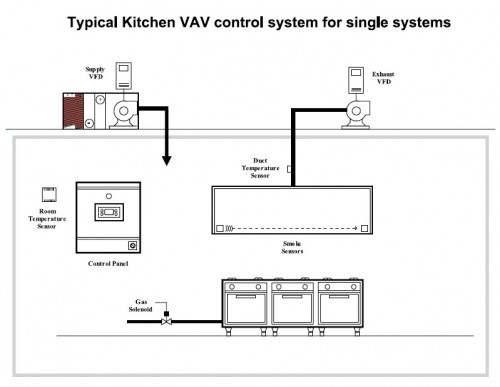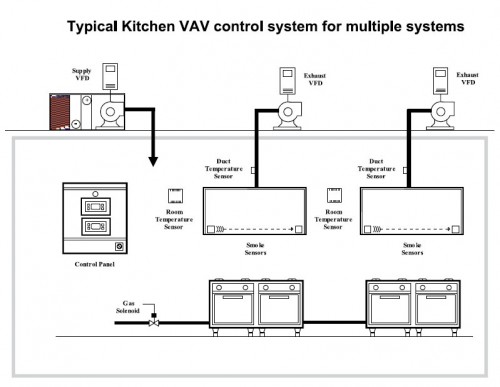20% Of Energy Costs Are To Condition Air
The average food service kitchen exchanges inside air for fresh outside air at least 20 times per hour. It sounds like an effective way to keep a kitchen comfortable and safe, but in most situations it is actually a huge drain on energy resources that provides no real health benefits to employees or guests. Roughly 25% of a food service operations energy costs go to conditioning the outside air brought in during these air exchanges, and according to estimates from the American Gas Association, the U.S. food service industry wastes more than $2 billion each year because of excessive ventilation.
Excessive Ventilation
Technology is typically the culprit. Until a few years ago, most kitchen ventilation controls consisted of a manual on/off switch and a magnetic relay or motor starter for each fan. Exhaust and make up fans either operated at 100% speed or not at all, and the whir of the exhaust fan was a common sound in the average commercial kitchen – even when cooking equipment was not in use. Manual two speed systems that relied on cools to switch from low to high speed and vice versa offered some energy savings but were seldom used efficiently.
Variable Volume Control
The TEL kitchen control system has changed all that. With microprocessor based controls whose sensors automatically regulate fan speed based on cooking load, time of day and hood temperature while minimising energy usage. The TEL system includes a temperature sensor installed in the hood exhaust collar, IP sensors on the ends of the hood that detect the presence of smoke or cooking effluent and variable frequency drives (VFD) that control the speed of the fans.
Variable Volume Hoods Reduce Running Costs And Increase Equipment Life…
If you’re not using a variable volume hood it is always at maximum design volume when running. The TEL Kitchen control system detects both smoke and temperature rise, increasing the volume when it is needed. Most kitchen hoods require full exhaust performance for only a small percentage of the day. Varying the speed of the fan as the cooking loads change will save money by reducing ventilation needs.
Benefits Go Beyond Energy Savings
Variable volume can also mean:
- A significantly quieter kitchen
Even relatively small decreases in speed can reduce the kitchen noise level. When the fans run at 80% speed, the air noise generated at the grease filters decreases more than 20%, when the fans run at 50% speed, the air noise is virtually eliminated.
The result: a more pleasant environment for employees and guests (when the hoods are located near customers). - Reduced HVAC equipment wear
Soft-starting the hood fans with a VFD extends belt life, and reducing the outside air load on the kitchen air conditioning units reduces compressor run time and extends life as well (this can also apply to refrigeration units inside the kitchen). In addition, reducing the makeup air decreases the rate at which the filters become dirty and need to be cleaned or replaced. - Decreased grease entrapment
Excessive fan speeds send grease up the duct, into the fan and out to the building roof, and sometimes, into the atmosphere. Slowing down the exhaust fans and reducing the air duct velocity allows the grease to drain back into the hood and into grease cups, where it can be easily disposed if, which reduces the frequency that the hoods and ducts need to be cleaned.


Features
- Single or Multiple Hood control.
- Ventilation On/Off from control panel or Auto On/Off on a time basis (from on board time clock or BMS).
- Up to 3 On/Off time periods per day using on board time clock.
- Can be set for annual time scheduling with holidays and exceptions.
- Measures the duct and room temperatures and uses the differential temperature to control the speed of the exhaust and supply fans to maintain good exhaust with minimum energy consumption.
- Compensates for heat gain in the room from other equipment by controlling to room temperature set point if the room temperature exceeds the set value.
- The smoke detector inside the hood will detect any sudden plumes of smoke and runs the ventilation at maximum speed for a set period of time or until the smoke has cleared.
- Auto Run feature if heat is detected outside of normal hours operation.
- Auto Run On feature to extend the ventilation running period until cooking has finished.
- Remote Emergency pushbutton to override the Automatic controls for a given period of time.
- Max/Auto/Standby operation modes.
- Selectable Metric / Imperial Units
- Modbus RTU and BACnet coms on board for connection to BMS.
- Graphic digital display with indication of ventilation output, temperatures and alarms.
- Pushbutton menu set up with password protection.
Gas Interlocking
Cutting off the gas flow in the event of kitchen ventilation failure is now a mandatory requirement in most commercial kitchens in the UK:-
- On installation of a completely new extraction/ventilation canopy
- On installation of a new pipe run
- On installation of a new cook line or layout
- When fitting any new or replacing any Category B equipment (Ovens/fryers/grills etc)
The optional Gas Interlock system senses the ventilation system pressure and switches off the gas flow if the ventilation fails. The gas flow is also switched off when the ventilation system is switched off from the Kitchen Hood controller.
The TEL kitchen hood VAV system can be supplied with an integrated Gas Interlock system



